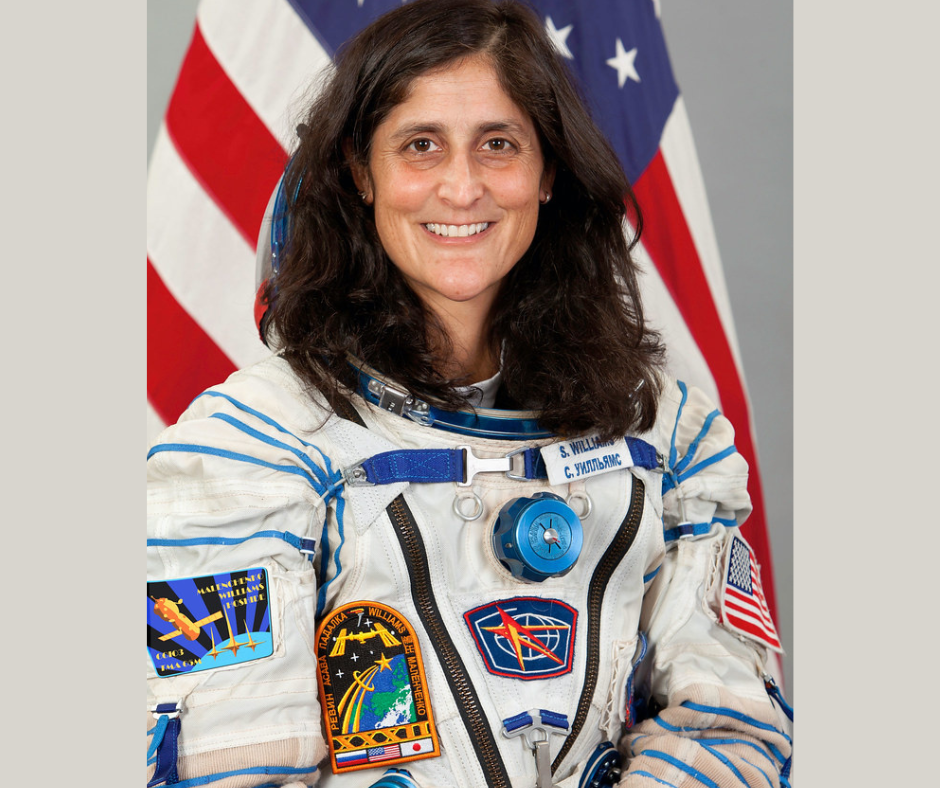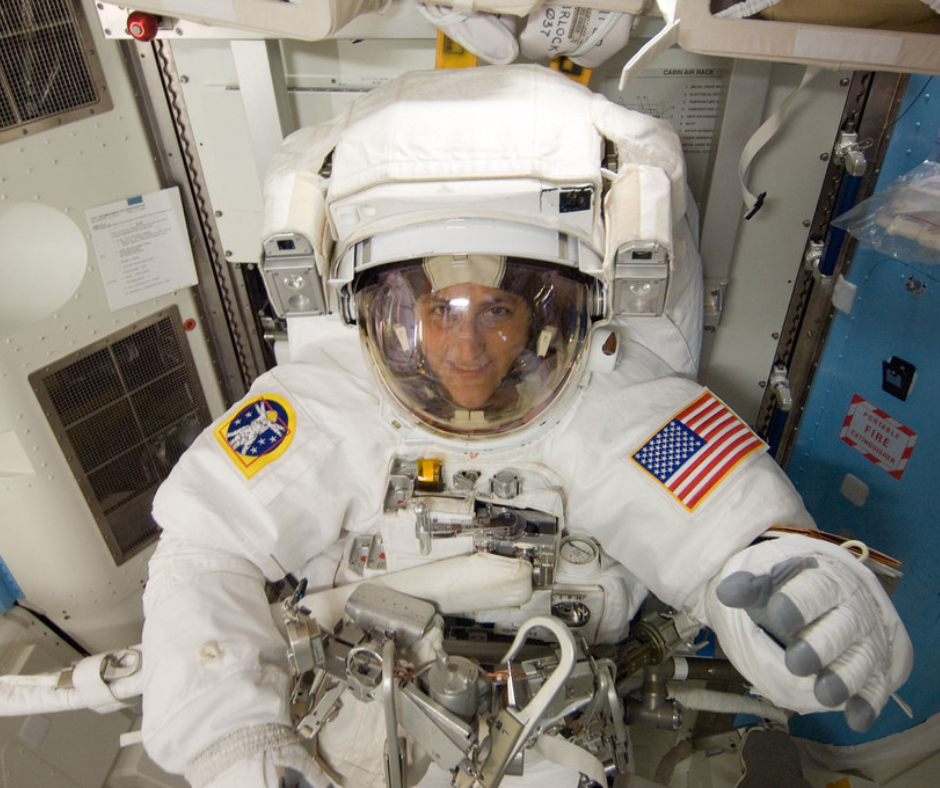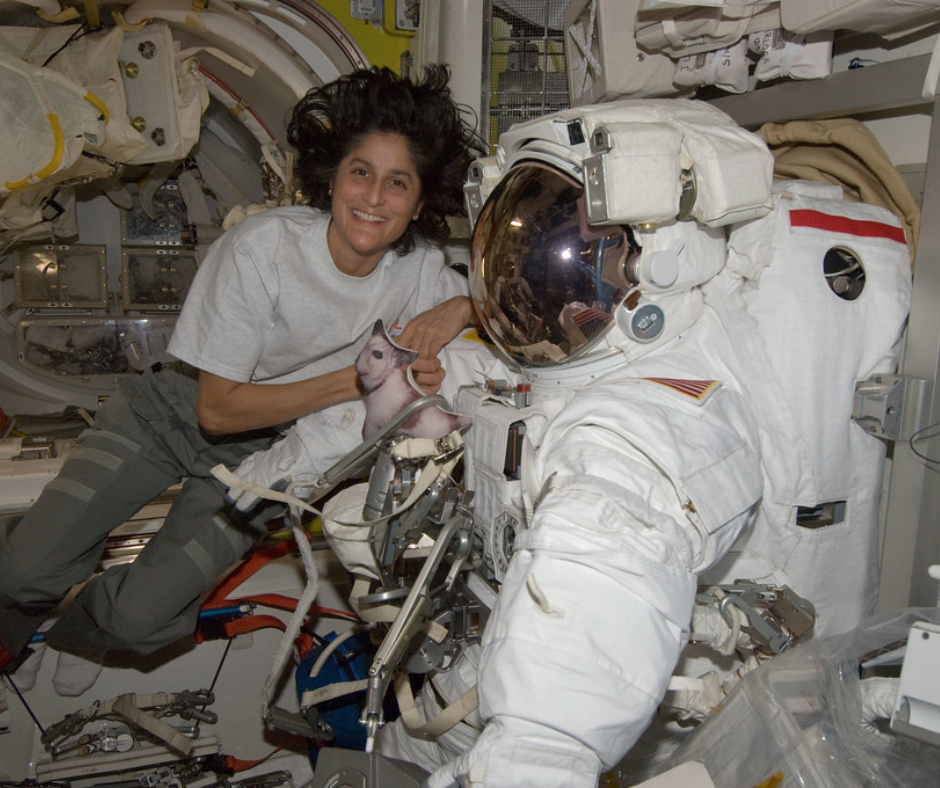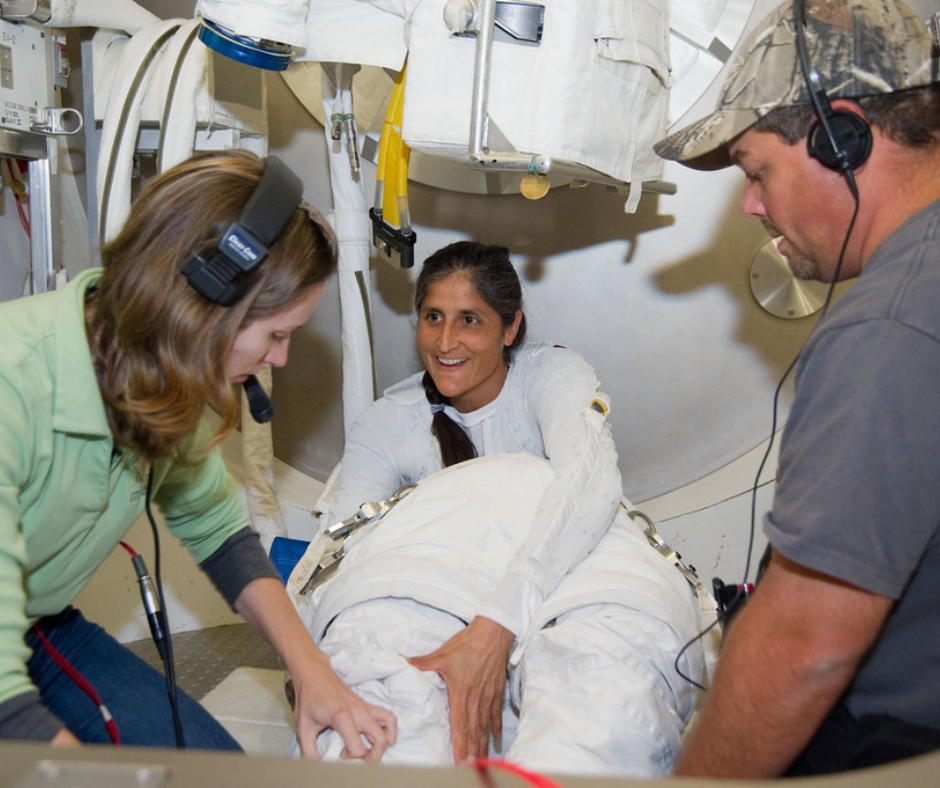A Detailed Study of Sunita Williams
Who doesn’t know the famous astronaut Sunita Williams? For 90’s kids, she was an idol figure to be inspired by and aspire to be like.
Sunita Williams, a distinguished American astronaut and retired Navy officer, was born on September 19, 1965, in Euclid, Ohio. Her father, Deepak Pandya, is a neuroanatomist of Indian-American descent, while her mother, Bonnie Pandya, has Slovene American roots. Sunita Williams graduated from the United States Naval Academy in 1987. later she earned a Master’s degree in engineering management from the Florida Institute of Technology in 1995. She began her naval career in 1987 and became a naval aviator in 1989. She was Selected as a NASA astronaut candidate in 1998. Williams has spent 321 days in space, consisting of two ISS missions. She holds multiple records and has received prestigious awards like the Padma Bhushan and Congressional Space Medal of Honor.

Spacewalk Experience:
Sunita Williams performed a total of four spacewalks during her two missions to the International Space Station (ISS). These spacewalks, also known as EVAs (extravehicular activities), were crucial for maintaining and upgrading the ISS.
Key Spacewalks:
Here’s the lil bit more detailed explanation of Sunita Williams’ first spacewalk. Sunita Williams’ first spacewalk took place on December 16, 2006, during the STS-116 mission. This was a NASA Space Shuttle
mission that launched on December 9, 2006, from Kennedy Space Center. The mission aimed to deliver a new segment to the International Space Station (ISS) and perform several spacewalks to
maintain and upgrade the ISS. Williams’ first spacewalk began at 1:41 PM EST on December 16, 2006. She stepped out of the ISS’s Quest airlock, accompanied by astronaut Robert Curbeam. The spacewalk,
also known as an extravehicular activity (EVA), lasted for 6 hours and 54 minutes. During the spacewalk, Williams and Curbeam performed several critical tasks.
They installed a new solar array on the ISS, which provided additional power to the station.
They inspected the ISS’s heat shield, which protects the station from extreme temperatures.
They also connected cables to support the new solar array and other
ISS systems. The spacewalk was not without challenges. They even had to navigate in the microgravity environment, where objects float and movements require careful planning.
They wore pressurized suits to protect themselves from the harsh conditions of space, which limited their mobility and visibility. They had to communicate with the ISS crew and Mission Control through
radio transmissions, which required careful coordination. Sunita Williams’ first spacewalk marked a significant milestone in her career as an astronaut. She demonstrated exceptional skills, adaptability,
and teamwork, which earned her recognition as a talented and dedicated spacewalker. This achievement paved the way for her future spacewalks and solidified her place in the history of space exploration.

Her second spacewalk took place on January 31, 2007, during the
STS-116 mission. This mission was a critical one, as it aimed to deliver a new segment to the International Space Station (ISS) and perform several spacewalks to maintain and upgrade the ISS. Actually
Williams and her fellow astronaut, Robert Curbeam, worked on installing a new solar array on the ISS. This array provided additional power to the station, enabling it to support more scientific
experiments and equipment. They also inspected the ISS’s heat shield, which protects the station from extreme temperatures. This inspection ensured that the heat shield was functioning correctly and
made any necessary repairs. They connected cables to support the new solar array and other ISS systems. During the spacewalk, Williams and Curbeam faced several challenges ,such as: they had to
navigate in the microgravity environment, where objects float and movements require careful planning. They wore pressurized suits to protect themselves from the harsh conditions of space, which limited
their mobility and visibility and they had to communicate with the ISS
crew and Mission Control through radio transmissions, which required careful coordination. Despite these challenges, Williams and Curbeam successfully completed their objectives, demonstrating
exceptional teamwork, skill, and adaptability. Williams’ second
spacewalk lasted for 6 hours and 45 minutes, beginning at 9:14 AM EST and ending at 4:09 PM EST. During this time, she and Curbeam worked efficiently to complete their tasks, ensuring the ISS’s
continued operation and upgrading its capabilities. Sunita Williams’ third spacewalk took place on February 4, 2007, during the STS-116 mission. This mission was a critical one, as it
aimed to deliver a new segment to the International Space Station (ISS) and perform several spacewalks to maintain and upgrade the ISS. They worked on installing a new coolant line on the ISS. This line
was essential for regulating the temperature of the station’s systems. They also connected cables to support the new coolant line and other ISS systems. And performed inspections on the ISS’s exterior. During the spacewalk, Williams and Curbeam faced several challenges here
also. They had to navigate in the microgravity environment, where
objects float and movements require careful planning also
hereplanning.he previous times they wore pressurized suits to protect themselves from the harsh conditions of space, which limited their mobility and visibility. They had to communicate with the ISS crew
and Mission Control through radio transmissions, which required
careful coordination. Despite these challenges, Williams and Curbeam successfully completed their objectives, demonstrating exceptional teamwork, skill, and adaptability. Williams’ third
spacewalk lasted for 6 hours and 38 minutes, beginning at 8:44 AM EST and ending at 3:22 PM EST. During this time, she and Curbeam worked efficiently to complete their tasks, ensuring the ISS’s
continued operation and upgrading its capabilities. Sunita Williams’ fourth extravehicular activity (EVA) took place on September 5, 2012. This spacewalk occurred during the Expedition 32
mission, marking her fourth excursion outside the International Space Station (ISS). Williams spent 6 hours and 28 minutes outside the ISS, focusing on critical maintenance tasks.

Sunita Williams’ fourth spacewalk took place during the Expedition 32 mission, which began on May 17, 2012, and ended on September 17, This mission was a long-duration stay on the ISS, with Williams
serving as the commander of the ISS. Williams and her fellow astronaut, Akihiko Hoshide, worked on replacing an ammonia pump on the ISS. This pump was essential for regulating the temperature of
the station’s systems. They also connected cables to support the new ammonia pump and other ISS systems. Williams and Hoshide performed inspections on the ISS’s exterior, checking for any signs of
damage or wear. During the spacewalk, Williams and Hoshide faced several challenges. They had to navigate in the microgravity environment, where objects float and movements require careful
planning They wore pressurized suits to protect themselves from the harsh
conditions of space, which limited their mobility and visibility. They had to communicate with the ISS crew and Mission Control through radio transmissions, which required careful coordination. Despite
these challenges, Williams and Hoshide successfully completed their objectives, demonstrating exceptional teamwork, skill, and adaptability. Williams’ fourth spacewalk lasted for 6 hours and 28 minutes, beginning at 8:30 AM EDT and ending at 3:00 PM EDT. During this
time, she and Hoshide worked efficiently to complete their tasks, ensuring the ISS’s continued operation and upgrading its capabilities. Sunita Williams’ spacewalks showcased her exceptional skills and adaptability in space. As an astronaut, Williams underwent rigorous training to prepare herself for the challenges of spacewalking. His training included some discipline. Williams had to maintain a high
level of physical fitness to withstand the physical demands of spacewalking. She had to acquire in-depth knowledge of the ISS’s
systems, including life support, propulsion, and communication systems. Williams trained in NASA’s Neutral Buoyancy Laboratory (NBL) to practice spacewalking skills, such as navigating in
microgravity and working with tools. Williams’ exceptional skills and adaptability enabled her to perform complex tasks during her
spacewalks. She performed routine maintenance and repair tasks on the ISS’s exterior, ensuring the station’s continued operation. Williams installed new equipment and upgraded existing systems, enhancing the ISS’s capabilities. She conducted inspections and testing of the ISS’s
systems, identifying potential issues and ensuring the station’s safety. Sunita Williams holds the record for the most spacewalks performed by a woman. Her four spacewalks, totaling 29 hours and 17 minutes,
demonstrate her exceptional skills and dedication to space exploration. She holds the record for the most spacewalks performed by a woman, with a total of four spacewalks. Williams spent a total of
29 hours and 17 minutes outside the ISS, demonstrating her endurance and adaptability in space. Her spacewalks contributed significantly to our understanding of space and the operation of the
ISS. Sunita Williams’ achievements have inspired countless individuals, particularly women and girls, to pursue careers in science, technology, engineering, and mathematics (STEM). Her legacy
extends beyond her record-breaking spacewalks, as she has .

How Sunita Williams Spent Months Among the Stars :
Sunita Williams, a NASA astronaut, spent a total of 322 days aboard the International Space Station (ISS) during her two missions, Expedition 14/15 and Expedition 32. Her experience living and working in space provides a unique insight into the daily life of an astronaut. This topic explores Williams’ daily routines, food, sleep, and workout regimes, offering a fascinating glimpse into life in space. Astronauts
like Sunita Williams follow a strict daily routine to ensure the smooth operation of the ISS. Her day typically began with Morning Exercise. Williams started her day with a 2-hour workout session, which
included cardio exercises, strength training, and flexibility exercises. This helped maintain her physical health and prevented muscle loss in microgravity. After her workout, Williams had breakfast, which usually
consisted of pre-prepared meals, such as scrambled eggs, sausage,
and pancakes. She used a specialized spoon to eat, as liquids and solids behave differently in microgravity. Williams attended a daily planning conference with her crew members and Mission Control to
discuss the day’s schedule, tasks, and any ongoing experiments. For
her eating in space was an unique experience, and astronauts like Williams have to adapt to new ways of consuming food. Most meals were pre-prepared and pre-cooked on Earth, then frozen or
thermostabilized to prevent spoilage. Food was packaged in specialized containers to prevent liquids and solids from floating away. Astronauts use a hydration system to drink water, which is
recycled from wastewater and condensed water vapor. Sleeping in space was also very challenging due to the lack of a normal day-night cycle and the noise level on the ISS. Williams had to adapt
to a new sleep schedule. Astronauts typically sleep for 8 hours, with their sleep schedule adjusted to accommodate the ISS’s orbit and the crew’s workload. Williams slept in a private sleeping quarter, which
was a small, curtained area with a sleeping bag attached to the wall to prevent floating away. Astronauts use sleeping aids like earplugs, eye masks, and white noise machines to improve sleep quality.
Exercise was also very crucial in space to maintain physical health and prevent muscle loss.That’s why Williams followed a rigorous workout regime. She performed cardio exercises like running,
cycling, and rowing using specialized equipment as well. Williams did strength training exercises using resistance bands and machines to maintain muscle mass. She performed flexibility exercises like yoga
and stretching to maintain flexibility and range of motion,too .

Conclusion :
Sunita Williams’ experience aboard the ISS provides a unique insight into the daily life of an astronaut. From daily routines and food to sleep and workout regimes, Williams adapted to the challenges of
living in space. Her story is an inspiration to space-curious readers, offering a glimpse into the fascinating world of space exploration.
